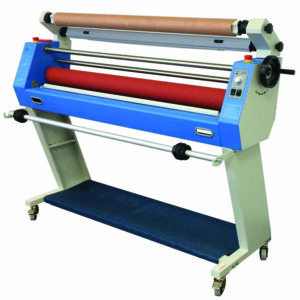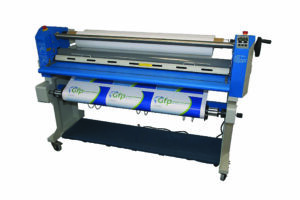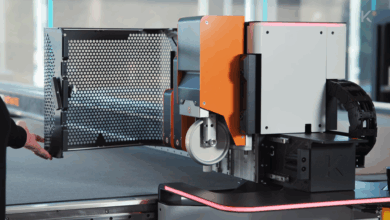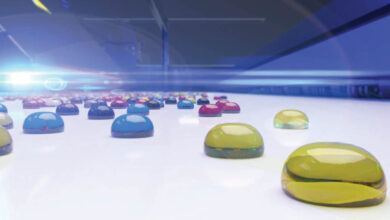High-end digital printers may be all the buzz, but finishing equipment is the cherry on top. Whether the machinery is hooked up inline or offline, all finishing equipment works in tandem with a shop’s printing system to perform value-added operations. Such features range from programmable cutting, folding, slitting, creasing, and binding to professional lamination, labeling, packaging, and much more.
“With plotters, specifically, they’re helpful in reading a registration mark that will align the print or cut an irregular shape,” said Frank Matheus, director of equipment at Reece Supply, a wholesale supplier in the sign, screen printing, and digital imaging industries. “Likewise, if someone is doing stickers and wants to do a full or kiss-cut to peel off the sheet, plotters can accomplish that.”
Finishing equipment is a necessary evil in day-to-day business, according to Sam Crosby, dealer manager at Graphic Finishing Partners (GFP). Without it, a project cannot cross the finish line. Yet all too often, small business owners struggle to see the forest for the trees and are reluctant to invest. Inevitably, they come face-to-face with a difficult decision: either turn down a job, or sub-contract the finishing work to another business with the capabilities — oftentimes, a direct competitor.
Matheus and Crosby agree neither option is attractive. Best case scenario, a shop loses revenue and incurs additional expenses to sub-contract the order. Worst case, the team sacrifices customers to a full-service operation.
While a lot of small businesses try “to get by” with just a print engine on-site, Crosby reminds fellow professionals that a job encompasses more than just a final print.
“You created the graphic but by itself, that doesn’t do much,” he said. “The finishing work is what makes it stand out — what makes it last longer and perform the way it’s actually intended to be used.”
With lamination, for example, the finishing equipment not only provides a durable UV layer against harsh outdoor elements, but also a more professional-looking graphic.
“That’s where our products come into play,” Crosby said. “We’re not ‘selling’ gromets or even lamination, per se; rather, we’re selling a proper finished product.”
Benefits in abundance

Consider the inordinate amount of effort and labor costs required to manually finish daily operations. Ultimately, time is money. The quicker and more efficient the turnaround, the greater the opportunity to drive new business opportunities.
Another leading benefit of finishing equipment is the ability to automate. Doing so not only improves operational efficiencies, but also reduces costs and enhances scalability. For example, on site folding is a massive time saver for screen printers that ship garments to brick-and-mortar retail outlets. A bagging feature also helps protect each garment from dirt, dust, and moisture, especially when heat sealed. Similarly, label functionality can color code by garment size or even include a SKU to simplify identification and sales processing.
In the end, screen printers deliver a professionally-presented finished product, while end users forego both the hassle and extra labor cost of doing such tasks upon receiving shipment.
Crosby and Matheus agree: the juice is worth the squeeze. With proper finishing equipment on board, business owners can expand and diversify — increasing reach, sales, and profitability, while ensuring a better all-around customer experience.
Better yet, since finishing equipment is generally less complex than modern digital printers, the product is replaced far less often, allowing business owners to reap the benefits of their investment long-term.
“Finishing equipment can be upgraded alongside a printing system, but that isn’t necessary. Traditionally, printers age more quickly compared to finishing equipment,” Matheus said. “If finishing equipment is well cared for, then it can last decades. I’ve replaced plotters that are 25 years old.”
While all finishing equipment adds a level of functionality that a standalone printer lacks, Matheus warns not all machinery is created equal. Industry professionals stress the importance of partnering with professionals who understand marketplace nuances, specialize in matching customers with the right product, and provide expert installation.
Ponder the possibilities
Before jumping into any purchase, it is important for owners to determine their business goals, consider the equipment features and functionality required to close the gap and select a reliable vendor with quality products capable of elevating one’s business to the next level.
Budget calculations should not only include the price tag of the new finishing machinery, but also employee training and the future cost of maintenance and repairs. In some cases, business owners may be able to leverage trade-in value of the old equipment and/or vendor financing options to help offset the initial investment.
“What’s important,” Crosby said, “is to invest in the right equipment up front, so you’re less likely to need yet another quick upgrade.”
He believes it is a mistake to invest heavily on a printing system, only to overlook the finishing equipment.
“Choosing the least expensive laminator is a poor decision because vendors manufacture different levels of equipment to accomplish different things,” Crosby said.
He points to GFP’s lineup as a solution. The company’s 300 series, for example, provides sign shops and digital printers with high-quality construction, labor-saving features, and high-quality output at an entry-level price point.
Built off the 255C cold laminator, the 300 series adds top heat for better over-lamination, mounting and board-coating results. With integrated rear rewind for roll-to-roll applications and a swing-up feed table at 38” output height, the 300 series is a popular choice to complete everything from signs, banners, displays and point-of-purchase materials to floor, window, and vehicle graphics.
Crosby affirms the 300 series is built to last but when it is time for a shop to upgrade its capabilities, the legacy laminator can easily transition to a dedicated workstation, while more advanced equipment handles the daily grind.
“Laminators that are well-maintained can last many years. Plus, since they are relatively affordable, it’s not uncommon to see shops run multiple laminators to handle specific processes [within their workflow]. Maybe the entry-level laminator is set up to do inexpensive sticker work and the newer one does vehicle graphics,” Crosby explained. “Investing in multiple laminators is still a fraction of the cost, compared to a [high-end] printer.”

Maximize the investment
Although cost is a crucial component, it should not be the driving factor in a purchase. Matheus said upgraded features and greater functionality, thus expanded business opportunities, all contribute to the overall value of the finishing equipment and help define the return on investment.
With the right machinery, business owners can streamline stubborn inefficiencies and outperform current production, while providing enough breathing room to handle the next notch of growth.
“Future proof the purchase,” Matheus emphasized. “Look slightly above your current needs – something a little faster and more feature-driven that you can work into, instead of [foolishly] buying the bare-bone basics, then quickly outgrowing that equipment.”
He admits medium to large shops are usually more forward-thinking in the purchasing process, thanks to higher revenue and better cashflow, but said it should not discourage small business owners from making smart investments today that pay larger dividends tomorrow.
Matheus points to the Mimaki CJV330 series, Graphtec FC9000 series, as well as GFP 300 and 500 series as sound investments for business owners.
The Mimaki CJV330 series is a flagship mid- to high-end eco-solvent inkjet printer and cutter combination. In addition to vibrant image quality and definition at top speeds, the CJV330 series features a XY slitter capable of reducing post-process work by X-axis & Y-axis sheet-fed cut.

At Graphtec, the FC9000 series is dubbed the most advanced and versatile roll-fed cutting plotter to date. With dependable, high-precision cutting capabilities on both printed and unprinted materials, the company describes the FC series as “the ultimate finishing solution” for a wide range of industries, including wide-format signage, apparel, and automotive applications.
The FC9000 series features a newly developed feeding system and cutting head, resulting in even better cutting quality for a range of thin and thick materials, including delicate window tint and high-intensity reflective materials.
In addition, Graphtec’s Datalink Barcode System streamlines job loading and processing automatically, further enhancing the product’s efficiency and productivity. Graphtec software includes a Cutting Master 5 plug-in for Adobe and Corel users, plus the popular Graphtec Studio 2 software for design and cut graphics.
While the GFP 300 and 500 series are tried and true, Crosby points to the GFP 663 series as the company’s most productive and convenient offering yet. The 63” top heat laminator features “Smart Finishing Technology,” with the option to set repeatable operating parameters.
“There is a big learning curve with a lot of machines. It takes time to know how to achieve the best results, but with 663, there are a lot of presets to remove the guesswork,” Crosby said.
In addition to highlighting a digital microcontroller system, plus color graphic operational displays and touchscreen user-interface, the electronic controller delivers precise gap and pressure stability. A variety of features like top roller heat assist, integrated rear rewind, inline slitting, and swing-out shafts provide the reliable performance finishing professionals need to ensure the highest quality output at maximum productivity.
Crosby credits the 663 series as an ideal solution for any shop that values accurate repetition of process (pressure, temperature, and speed), or mid- to large businesses wanting to better manage their inventories. He specifically calls out the machine counters, which help staff reduce the number of remnant partial roles, thereby decreasing waste and increasing profitability. So long as an operator is inputting the correct data, he said a label can be printed out to identify the remaining product — making it easier for a shop to keep track of exactly what is on hand.
Regardless of which make and model a business turns to for their finishing needs, industry professionals encourage owners to focus on the priorities during any purchase – features, functionality, and future growth. Making the investment, they agree, is little risk and high reward.



